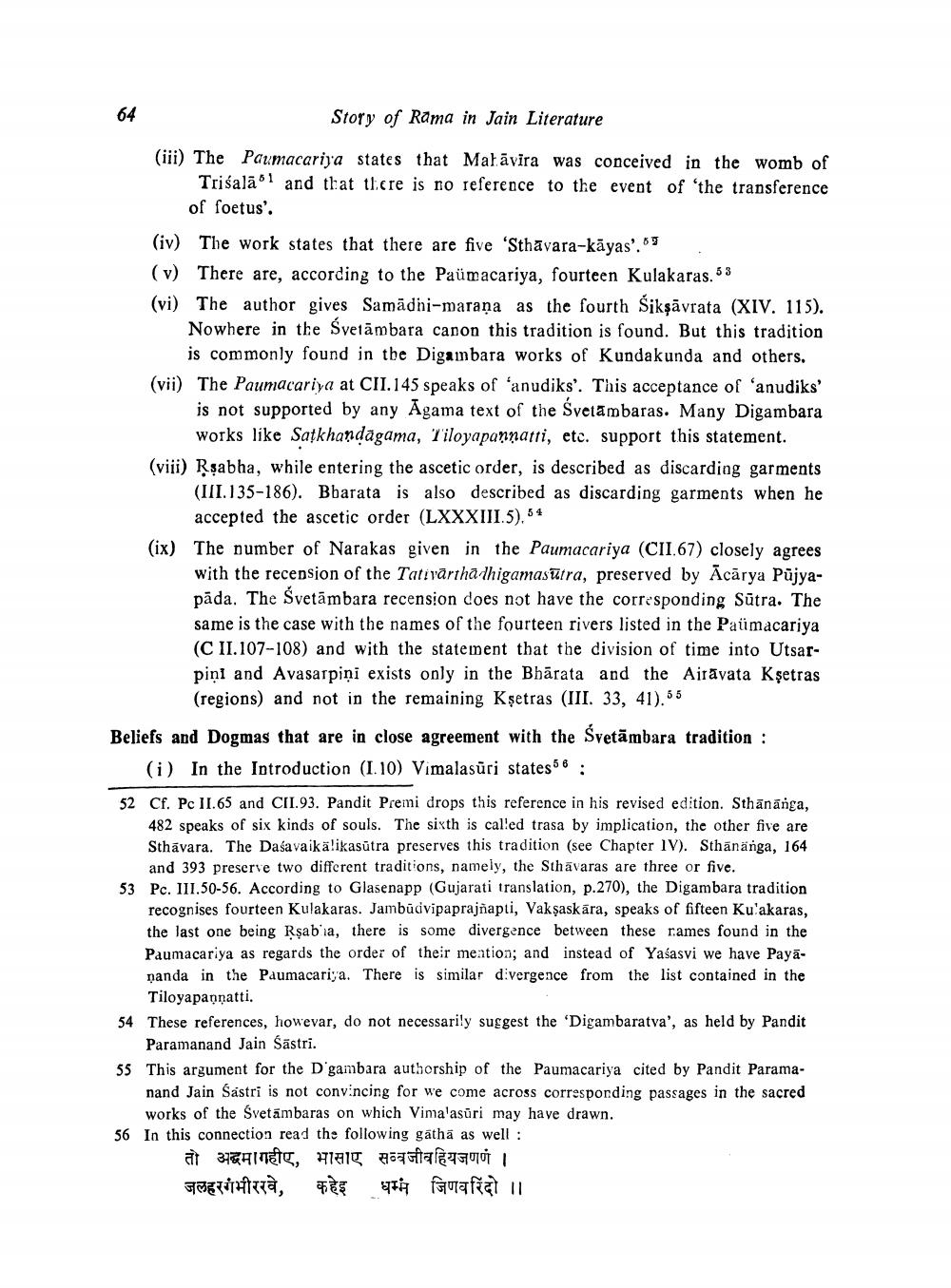________________
Story of Rama in Jain Literature
(iii) The Paumacariya states that Malāvira was conceived in the womb of
Trisala 1 and that there is no reference to the event of 'the transference
of foetus'. (iv) The work states that there are five 'Sthavara-kāyas'. 69 (v) There are, according to the Paümacariya, fourteen Kulakaras. 53 (vi) The author gives Samādni-maraña as the fourth Sikşāvrata (XIV. 115).
Nowhere in the Svetāmbara canon this tradition is found. But this tradition
is commonly found in the Digambara works of Kundakunda and others. (vii) The Paumacariya at CII.145 speaks of 'anudiks'. This acceptance of 'anudiks'
is not supported by any Agama text of the Svetambaras. Many Digambara
works like Satkhandägama, Tiloyapannatti, etc. support this statement. (viii) Rşabha, while entering the ascetic order, is described as discarding garments
(III.135-186). Bbarata is also described as discarding garments when he
accepted the ascetic order (LXXXIII.5), 54 (ix) The number of Narakas given in the Paumacariya (CII.67) closely agrees
with the recension of the Tati vārtha thigamasutra, preserved by Ācārya Pujyapāda. The Svetāmbara recension does not have the corresponding Sūtra. The same is the case with the names of the fourteen rivers listed in the Paümacariya (C II.107-108) and with the statement that the division of time into Utsarpini and Avasarpiņi exists only in the Bhārata and the Airavata kşetras
(regions) and not in the remaining Kșetras (III. 33, 41).55 Beliefs and Dogmas that are in close agreement with the Svetāmbara tradition :
(i) In the Introduction (I.10) Vimalasūri states 58 ;
53
52 Cf. Pc II.65 and CII.93. Pandit Premi drops this reference in his revised edition. Sthānānga,
482 speaks of six kinds of souls. The sixth is called trasa by implication, the other five are Sthāvara. The Daśavaikälikasūtra preserves this tradition (see Chapter IV). Sthānänga, 164 and 393 preserve two different traditions, namely, the Sthāvaras are three or five. Pc. 111.50-56. According to Glasenapp (Gujarati translation, p.270), the Digambara tradition recognises fourteen Kulakaras. Jambūdvipaprajñapti, Vaksaskāra, speaks of fifteen Kulakaras, the last one being Rşabia, there is some divergence between these rames found in the Paumacariya as regards the order of their meation; and instead of Yaśasvi we have Payananda in the Paumacariza. There is similar divergence from the list contained in the
Tiloyapannatti. 54 These references, howevar, do not necessarily suggest the 'Digambaratva', as held by Pandit
Paramanand Jain Sastri. 55 This argument for the D'gambara authorship of the Paumacariya cited by Pandit Parama
nand Jain Sastri is not convincing for we come across corresponding passages in the sacred
works of the Svetāmbaras on which Vimalasūri may have drawn. 56 In this connection read the following gatha as well :
तो अद्धमागहीए, भासाए सव्वजीव हियजणणं । जलहरगंभीररवे, कहेइ धम्म जिणवरिंदो ।।




